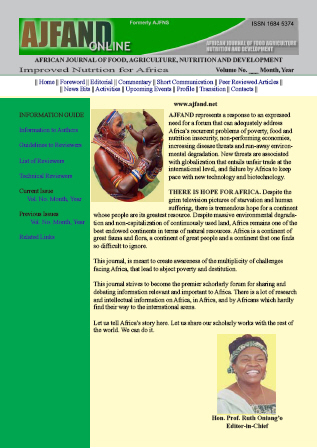
|
African Journal of Food, Agriculture, Nutrition and Development
Rural Outreach Program
ISSN: 1684-5358 EISSN: 1684-5374
Vol. 1, Num. 2, 2005
|
Untitled Document
African Journal of Food Agriculture Nutrition and Development, Vol. 5, No. 2 , 2005
Book Review
Principles of Nutritional Assessment by Rosalind S. Gibson
Kennedy M. Shiundu and Hon. Prof Ruth K. Oniang'o
Code Number: nd05033
In this issue we have included reviews of a few books that we thought are
important in the field of food, agriculture, nutrition and development. Please
read and
tell us what you think
Title: Principles of Nutritional Assessment (Second Edition)
Author: Rosalind S. Gibson
Publisher: Oxford University Press, Inc
Reviewer: Kennedy M. Shiundu and Hon. Prof Ruth K. Oniang'o
Principles of Nutritional Assessment gives up-to-date comprehensive, well illustrated
and most current ideas in the area of nutritional assessment of populations.
Nutritional assessment is an invaluable component of nutritional practice.
The book is broadly divided into 27 chapters with sub-sections. The issues
covered range from basic nutritional assessment systems, food consumption at
the national and household levels, validity of dietary assessment methods,
evaluation of anthropometric indices, laboratory assessment of body compositions
and micronutrients, clinical assessment and nutritional assessment of hospital
patients.
Nutritional assessment systems have been undergoing revision over the last
couple years. Among the common nutritional assessment methods include nutrition
surveys, nutrition surveillance, nutrition screening, nutrition interventions
and clinical assessments in clinical settings. Gibson has discussed in the
book some of the new nutritional assessment techniques such as measurement
of nutrients in dried blood spots prepared from a finger-prick blood sample.
In addition, for some nutrients, on-site analysis is now possible, enabling
researchers and subjects to obtain results immediately. The author equally
reserved ample time for comprehensive and critical appraisal of many of the
older, established methods in nutritional assessment like nutrition surveys.
Nutritional methods are based on a series of dietary, laboratory, anthropometric
and clinical observations. The current practice is now to apply nutritional
systems to define multiple levels of nutrients' status, and not just
the level associated with a nutrient deficiency. Apart from the conventional
nutritional assessment methods such as dietary and biochemical assessments,
there is increasing emphasis on the use of new functional tests to determine
these multiple levels of nutrient status, such as functional tests that measure
immune function and oxidative stress.
Raw measurements arising from various nutritional assessment methods - on
their own -have no meaning unless they are related to, for example, the age
or sex of an individual. In this book, Gibson explains that raw measurements
derived from each of the four methods are often (but not always) combined to
form ‘indices'. Such combinations include height-for-age percentile
and nutrient density (i.e., nutrient intake per megajoule). Indices are evaluated
at the population level by comparison with predetermined reference limits or
cut-off points resulting into indicator concept, a term that relates to their
use in nutritional assessment.
The author avers that for optimal utilization of time and resources, the design
of nutritional assessment systems is critical. The assessment system used,
the type and number of measurements selected, and the indices and indicators
derived from these measurements will depend on a variety of factors including
study objectives, sampling protocols, calculating sample size, validity, reproducibility
or precision, accuracy, random errors, systematic errors or bias, confounding
factors, sensitivity, specificity, prevalence, predictive value, ethical issues
and additional factors.
The book also provides a detailed account when it comes to evaluation of nutritional
assessment indices. These indices can be evaluated by comparison with a distribution
of reference values (if available) using percentiles, standard deviations scores
(Z-scores), or the percent-of-median. Alternatively, for classifying individuals,
the values for nutritional assessment indices can be compared with either predetermined
reference limits drawn from the reference distribution or cut-off points. The
latter are based on data that relate to the levels of indices to low body stores
of the nutrient, impaired function, clinical signs of deficiency, or mortality.
Sometimes, more than one reference limit or cut-off point is used to define
degrees of malnutrition (e.g., for body mass index).
Principles of Nutritional Assessment is no doubt an excellent piece of work.
Copyright
2005 - Rural Outreach Program
|
